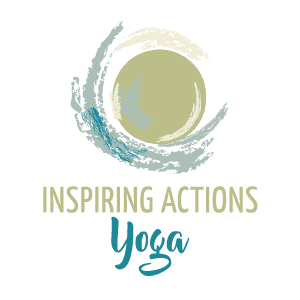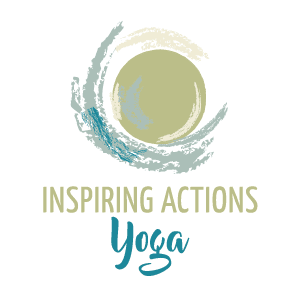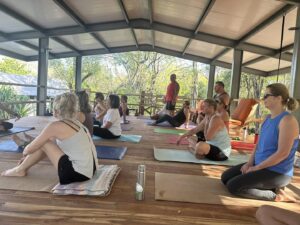What is Ashtanga Yoga?
When I was first introduced to yoga, I found myself confused on the different styles of asana (the postures of yoga) and wondered whether I was doing the “right” kind. Once I got more involved with my practice, I started to learn about the various terms and jargon, and it helped me have a deeper understanding of what I was doing, and how it could help me.
You may have heard of hatha yoga, vinyasa, ashtanga. These words sound lovely, but knowing what they mean can help direct and deepen your practice. In this post, we’ll focus on ashtanga yoga, as it is by far the most popular style of yoga in our Western world. We’ll also take a brief look at some other terms commonly associated with yoga, to gain a basic understanding.
Yoga Terms Defined: Hatha, Vinyasa, Ashtanga
Some of the most common terms you’ll see when scrolling through our class list at Inspiring Actions are hatha yoga, vinyasa, and ashtanga. Hatha can be thought of as an umbrella term for several styles of yoga, encompassing both vinyasa and ashtanga. Hatha essentially refers to the pairing of movement and breath.
Most other physical practices of yoga stem from Hatha yoga, which was the focus of Patanjali’s Yoga Sutras, written around 400AD. The Sutras are considered the “textbook” of yoga and they outline an Eight Limb Path of spiritual discipline designed to reach enlightenment. At Inspiring Actions, we learned about each of the steps on the Eight Limb Path of Yoga; check out the overview post here, or our blog page here to read about the individual steps!

Vinyasa-style yoga is a sequence-focused practice, stringing movements together using the breath. It is typically more fast-paced than a traditional hatha class, and may incorporate both standing and sitting postures, as well as stretching.
Pranayama, or controlled breathing, is often used as well, and participants are encouraged to bring their attention back to their breath rather than focus on doing a posture correctly.
The main difference between a vinyasa-style class and ashtanga, is that a vinyasa will vary from class to class, whereas ashtanga follows a set sequence of poses. This offers an excellent opportunity for beginners. When I started doing yoga, I started very much in an ashtanga class.
It was great for me because I knew what to expect. I could also start to see how the poses became more familiar and comfortable to me over time. From there, I started exploring different kinds of classes to expand my horizons and challenge myself.
Key Concepts of Ashtanga Yoga
In Sanskrit, the word ashtanga can be broken down into two words. ‘Ashta’ refers to the number eight, and ‘anga’ means limb. Ashtanga yoga is thought of as the manifestation of the Eight Limb Path of Yoga (read more about that here!). Through focus, movement, controlled breathing, and a general sense of letting go, ashtanga yoga is a key step on the path to enlightenment.
Drishti
Ashtanga yoga uses several key concepts that can help improve your practice, or bring deeper meaning to your time spent on the mat. One of these is focus, or in Sanskrit, ‘drishti’. A teacher explained to me that our drishti is when we mindfully focus on one thing with our eyes to help us maintain our posture, much like a ballerina returns her gaze to the same spot as she spins around and around, to keep from losing balance. Losing balance happens all the time in yoga though; this same wise teacher told me that if I’m not falling at least once during class, I’m not doing it right!

Chaturanga
Chaturanga is an essential part of an ashtanga class. It is a transitional movement; a way to get from one standing posture to another. Chaturanga starts out in high plank, then low plank, then upward dog, and ends in downward dog. If any of those terms are like a foreign language to you, check out this super helpful video. It shows how to properly (meaning, safely) do chaturanga, and includes variations for you to find your comfort level.
Sun Salutations
Ashtanga-style asana classes begin with Surya Namaskara, or Sun Salutations. There are two variations, Sun A and Sun B, and a typical ashtanga class will begin with five repetitions of each. Sun Salutations warm up the muscles and wake up the spine, stimulating the flow of prana, or life energy, in our systems. Practicing Surya Namaskara will strengthen and tone your muscles, as well as increase flexibility. This video gives you a quick introduction to both variations of Sun Salutations.
What Will an Ashtanga Yoga Class be Like?
You can expect that an ashtanga yoga class will be medium-paced, and will incorporate sequences that promote strength, flexibility, and balance. Sun Salutations are used as a warm-up, as well as throughout the rest of the class, and chaturangas are used to flow from one pose to the next. An ashtanga class can be challenging, depending on the level of class you are taking, but your instructor should always introduce alternative variations to any posture that could be challenging or cause injury.
Our instructors at Inspiring Actions are great at this, and there is no experience necessary to join us in our studios in Hudson and River Falls, Wisconsin! If you’re more comfortable practicing in the comfort of your own cozy yoga spot, we offer classes completely online! Check out our full list of classes and events; we have something for everyone!
If you’re still a little unclear on all these yoga terms, don’t worry. It’s not necessary to know or understand the jargon or philosophy of yoga to reap its’ benefits. Over time and with consistent practice, yogic concepts have a way of introducing themselves to you by sparking your curiosity and desire for personal, spiritual growth. Come visit us at Inspiring Actions to find out for yourself!




